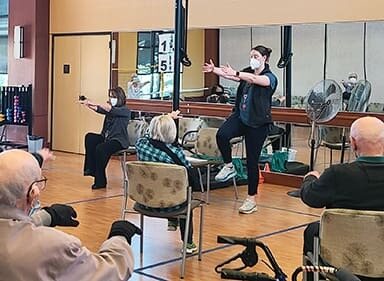Mobility is one of the keys to life lived well — allowing you to get up, move around and do the things you want (without pain). But mobility can decline through the years. The value of being able to take a joint through its range of motion (say, extending and flexing an elbow or ankle) is that it supports your ability to move or walk freely and easily; that’s critical for functioning well and living independently, according to the National Institute on Aging (NIA).
As we age, we may experience changes to our mobility. There are many reasons for these changes, including changes in gait (how we walk), balance and physical strength. All of these can increase the number and severity of falls and make it harder for older adults to go out and visit with friends and family and continue doing their activities independently. Older adults who lose their mobility are less likely to remain living at home; have higher rates of disease, disability, hospitalization and death; and have poorer quality of life. Studies have shown that regular exercise improves physical performance; the question remains: “Where do I start?”

The wellness team at Spring Lake Village is here to help. The health of our residents is of the upmost importance to us and we are happy to play a role in their mobility. The team has identified five skills associated with longer independent living: lower body strength, upper body strength, flexibility, balance and agility.
One way that the wellness team helps to track changes in physical performance is through annual fitness and balance evaluations we offer free of charge to all residents. The assessment of these five skills associated with longer independent living assists the wellness team in many ways.
Assessment facilitates the early identification of older adults who are beginning to experience significant changes in multiple body systems and helps us develop an appropriate exercise plan that targets the identified impairments. When these assessments are administered on a yearly basis, the information obtained can be used to help set appropriate short- and long-term goals and motivate residents to meet each of these goals.
Here is an explanation of the five assessments:
- The Sit to Stand Test measures lower body strength that is needed for numerous tasks — climbing stairs; walking; and getting out of a chair, tub or car. Increased ability in performing this test item indicates a reduced chance for falling.
- The Arm Curl Test assesses upper body strength that is needed for performing household and other activities involving lifting and carrying things, such as groceries, suitcases and grandchildren or pets. Both upper- and lower-body muscular strength can be a powerful predictor of the onset of disability in later years. Research also shows that, through increased exercise, it is possible for people of any age to regain some portion of lost strength and muscle mass and, as a result, experience improved functional mobility.
- The Flexibility Test examines range of motion in the joints of the upper and lower body. Flexibility is needed for good mobility, including bending, stooping, lifting, reaching, walking and stair climbing. Lower-body flexibility, especially in the hip joint and hamstrings, helps prevent low back pain, injury and gait abnormalities, as well as reducing the risk of falls. In the upper body (shoulder area), flexibility is needed for a number of specific functional tasks, such as combing hair, zipping a back zipper, putting on or removing over-the-head garments and reaching for a seat belt. Decreases in upper body flexibility can result in pain and postural imbalances and can cause significant disability. Even though both upper and lower body flexibility decline with age, improvements can be made through exercise and are important aspects of functional fitness for older adults.
- The Balance Tests that are done during the annual wellness and fitness evaluation are designed to measure subtle changes in both static and dynamic balance activities performed in different sensory environments. These tests can be used to identify older adults who may be experiencing increased fall risk and the possible underlying impairments. Despite the many age-related changes occurring in the multiple systems that contribute to good balance and mobility, growing evidence suggests that we can reverse or at least slow the rate of decline occurring in some or all of these areas of balance.
- Agility (the ability to move the body and change direction quickly) is important for a number of common mobility tasks that require quick maneuvering — such as getting on and off a bus in a timely manner; getting across the street before the light turns red; moving out of the way to avoid an accident; getting up quickly to answer a phone call or the door or go to the bathroom. Agility is also crucial for many recreational games such as pickleball, bocce and tennis. Studies indicate that performance on an agility test is related to walking speed, and can be a predictor of falls, and identify older adults at risk for loss of functional mobility.
At Spring Lake Village, our entire staff is dedicated to helping our residents live their best lives.







